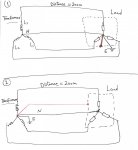Greetings,
if the distance between transformer and load is 200m . what is the difference between :
1-connection between neutral and earth at transformer.
2- connection between neutral and earth at load.
Physically: neutral is connected to earth in two cases.so, can i consider that the earthing system in two cases is TNS??

if the distance between transformer and load is 200m . what is the difference between :
1-connection between neutral and earth at transformer.
2- connection between neutral and earth at load.
Physically: neutral is connected to earth in two cases.so, can i consider that the earthing system in two cases is TNS??


